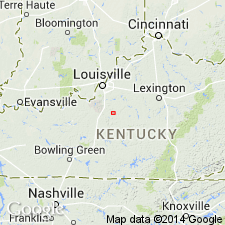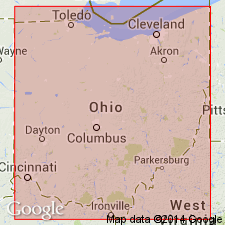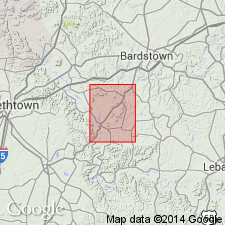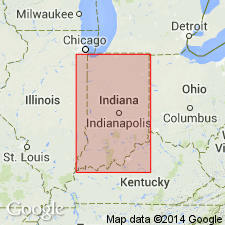
- Usage in publication:
-
- Beechwood limestone member*
- Modifications:
-
- Named
- Dominant lithology:
-
- Limestone
- AAPG geologic province:
-
- Cincinnati arch
Summary:
Named Beechwood limestone member of Sellersburg limestone. Composed of limestone. The lower part is generally light gray and fairly coarsely crystalline, while the upper part is finer grained and darker gray. Joints of crinoid stems are abundant, which give some parts a coarsely crystalline appearance. Lower few inches to 1 foot contains, in places, abundant black phosphatic nodules. Contains brachiopods, pelecypods, bryozoans, and crinoids. Thickness probably does not exceed 6 feet in vicinity of Louisville, Kentucky. Underlain by Silver Creek member of Sellersburg limestone; overlain by New Albany shale.
Source: GNU records (USGS DDS-6; Reston GNULEX).

- Usage in publication:
-
- Beechwood limestone [member]
- Modifications:
-
- Areal extent
- AAPG geologic province:
-
- Cincinnati arch
Summary:
Beechwood limestone [member] of Sellersburg limestone extended south from Jefferson County, Kentucky, to Nelson County, Kentucky.
Source: GNU records (USGS DDS-6; Reston GNULEX).

- Usage in publication:
-
- Beechwood member
- Modifications:
-
- Revised
- AAPG geologic province:
-
- Cincinnati arch
Summary:
Designated Beechwood member of North Vernon limestone.
Source: GNU records (USGS DDS-6; Reston GNULEX).

- Usage in publication:
-
- Beechwood Limestone Member*
- Modifications:
-
- Overview
- AAPG geologic province:
-
- Cincinnati arch
Summary:
Designated Beechwood Limestone Member of Sellersburg Limestone. Described as yellowish-gray limestone; coarse- to very coarse grained, clastic, thick bedded. Unit appears to be composed of one bed in many places but locally composed of two or more beds with shale partings. Contains abundant large spiked crinoid columnals, scattered brachiopod valves, horn corals, colonial corals, stromatoporoids, and scarce crinoid calyces. Thickness ranges from 0 to 8 feet. Unconformably overlies Louisville Limestone; underlies New Albany Shale.
Source: GNU records (USGS DDS-6; Reston GNULEX).

- Usage in publication:
-
- Beechwood Member*
- Modifications:
-
- Biostratigraphic dating
- AAPG geologic province:
-
- Illinois basin
- Cincinnati arch
Summary:
Conodont biostratigraphy indicates that the Beechwood Member of the North Vernon Limestone in Indiana is of Middle Devonian (Givetian) age. Conodonts from the VARCUS, HERMANNI-CRISTATUS, and DISPARILIS Zones were recovered from the Beechwood. Unit unconformably underlies the Blocher Member of the New Albany Shale.
Source: GNU records (USGS DDS-6; Reston GNULEX).
For more information, please contact Nancy Stamm, Geologic Names Committee Secretary.
Asterisk (*) indicates published by U.S. Geological Survey authors.
"No current usage" (†) implies that a name has been abandoned or has fallen into disuse. Former usage and, if known, replacement name given in parentheses ( ).
Slash (/) indicates name conflicts with nomenclatural guidelines (CSN, 1933; ACSN, 1961, 1970; NACSN, 1983, 2005, 2021). May be explained within brackets ([ ]).

